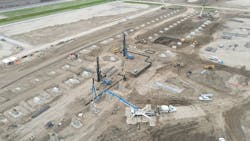Utility Business Notes: Quanta Invests In Steel Mill and Siemens Buys Switchgear Maker
Infrastructure services titan Quanta Services Inc. has invested an undisclosed amount in an Arkansas company that’s building a scrap metal recycling steel rebar mill.
The team behind Hybar LLC last year raised $700 million to build and begin running the mill in Osceola, about 50 miles north of Memphis. The project is rising near both the Mississippi River and a rail line and will focus on making steel rebar that will be used mainly in large infrastructure work—hence the direct connection to Quanta. Backers expect the mill to begin operations by late next summer.
“Quanta’s investment in Hybar provides an attractive growth opportunity and supports our goal of ensuring domestic sustainable supply of materials for our projects at cost-effective pricing in the market,” Quanta COO Redgie Probst said in a statement.
In making its equity investment, Houston-based Quanta joins TPG Rise Climate, Koch Minerals & Trading and Global Principal Partners, the investment vehicle of Hybar’s top managers.
Siemens acquires California switchgear company
The leaders of Siemens AG plan to broaden the company’s lineup of electrical networking products by buying a California switchgear manufacturer that employs about 130 people.
Siemens last week announced it expects to complete the acquisition of Trayer Engineering Corp. by year's end. Trayer, which was founded in 1962, specializes in hermetically sealed padmount and submersible switchgear that can withstand flooding and other tough conditions.
“We see a significant growth opportunity in secondary power distribution, particularly in addressing the challenges posed by extreme weather conditions,” Stephan May, CEO of electrification and automation at Siemens Smart Infrastructure, said in a news release. “By combining forces, we will provide an end-to-end portfolio to our customers by unlocking resources and competencies to serve this growing demand.”
Offshore blade incidents to push GE Vernova wind unit to Q3 loss
Bouncing back from three offshore wind turbine blade accidents this year and speeding up work to complete the installation at the two wind farms involved will result in the wind segment of GE Vernova Inc. taking a roughly $300 million EBITDA loss in the third quarter.
Speaking to a Morgan Stanley conference in California last week, CEO Scott Strazik said the separate incidents at the Vineyard project offshore Massachusetts and at a North Sea project off the English coast—the company has said the incidents are not related—set back GE Vernova’s timeline for wrapping up its work there, especially because they occurred during the typically more productive summer months. The GE Vernova team is now pushing to accelerate its installation and commissioning activities at Vineyard and Dogger Bank and “bring this chapter of offshore wind to a close.”
“We’ve got to rebuilt momentum on that process because time is an enemy for us here, although we’re going to do everything safety and quality first,” Strazik said. “The longer it takes to execute on the project, the longer you’re funding a marshalling harbor, the longer you’re paying for vessels.”
But doing so will cost the company in the short term: Strazik said the extra costs GE Vernova needs to take on will push its wind division into the red this quarter even though onshore wind work will put up a fifth consecutive profitable quarter. The company’s leaders aren’t changing their overall 2024 outlook, however, thanks to “incremental strength” in both its power and electrification segments.
Shares of GE Vernova (Ticker: GEV) finished last week’s trading at $226 apiece, having gained more than 10% since the previous Friday. The uptick has grown the company’s market capitalization to more than $62 billion.
About the Author
Geert De Lombaerde
Senior Editor
A native of Belgium, Geert De Lombaerde has more than two decades of business journalism experience and writes about markets and economic trends for Endeavor Business Media publications T&D World, Healthcare Innovation, IndustryWeek, FleetOwner and Oil & Gas Journal. With a degree in journalism from the University of Missouri, he began his reporting career at the Business Courier in Cincinnati and later was managing editor and editor of the Nashville Business Journal. Most recently, he oversaw the online and print products of the Nashville Post and reported primarily on Middle Tennessee’s finance sector as well as many of its publicly traded companies.
